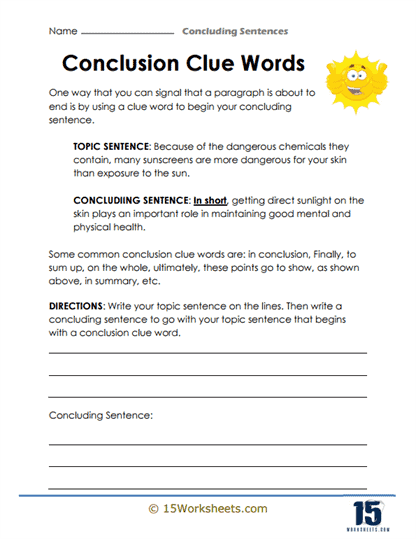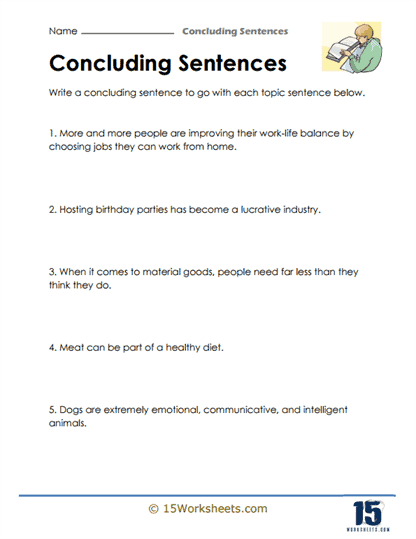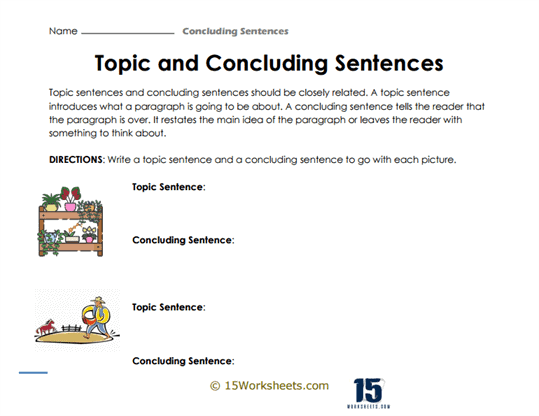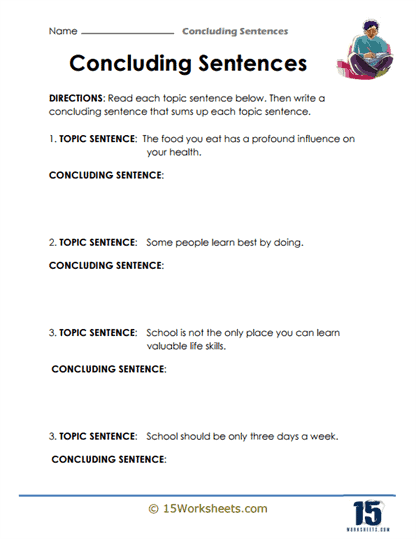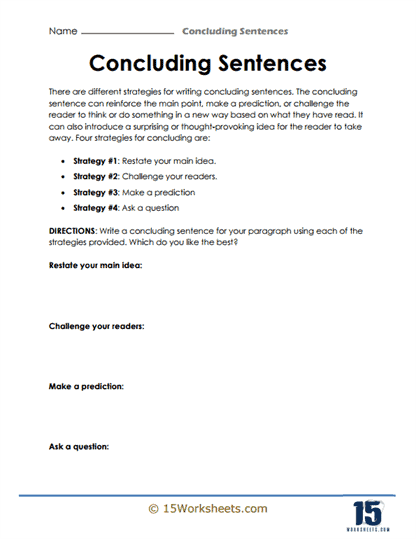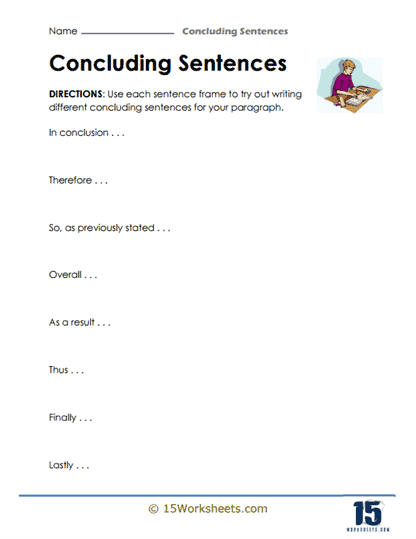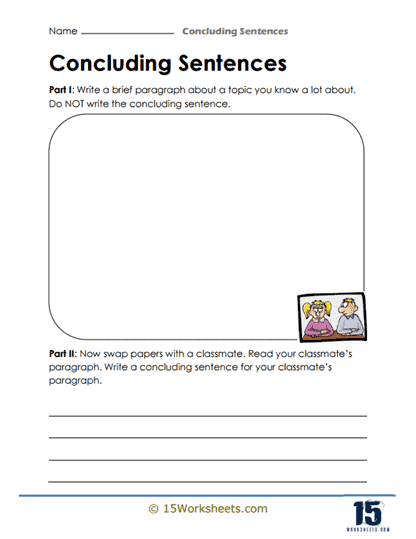Concluding Sentences Worksheets
All About These 15 Worksheets
So, imagine you’re telling a story to your friends. You’ve got this awesome plot going, the characters are really cool, and there’s a big twist at the end. But, just as your story is about to finish, you stop. No ending, no wrap-up, nothing. Your friends are left hanging, wondering what happens next or what the point of the story was. It’s kinda frustrating, right? This is similar to what happens when we write paragraphs without concluding sentences.
These worksheets help you understand how to end your paragraphs effectively. They guide you through the process of crafting concluding sentences, which are the final sentences that wrap up your thoughts or ideas.
Think of the concluding sentence like the ‘period’ at the end of your spoken story. It signals that your paragraph (or story) is coming to a close and it summarizes what you’ve been talking about. It helps your reader understand the main point of your paragraph and leaves them with a clear picture of your thoughts. They’re there to show you what a good concluding sentence looks like. Practice exercises, on the other hand, are like soccer drills – the more you do them, the better you get at creating your own concluding sentences. These exercises often include incomplete paragraphs where you need to fill in the final, concluding sentence.
For example, you might get a paragraph about the life cycle of a butterfly that goes like this: “Butterflies go through a process called metamorphosis. They start off as eggs, then become caterpillars, then form a chrysalis before turning into butterflies.” The concluding sentence could be: “In conclusion, the transformation from a tiny egg to a beautiful butterfly is a remarkable journey.”
Writing concluding sentences can be a bit tricky at first, because you want to make sure you’re summarizing your ideas without just repeating them exactly. That’s why Concluding Sentences Worksheets are really helpful. They give you the chance to practice this skill and get feedback on how you’re doing.
What Is a Concluding Sentence?
A concluding sentence is the final sentence of a paragraph or essay that wraps up the main points or ideas discussed and provides closure to the reader. It serves as a summary or synthesis of the information presented, and it helps reinforce the main message or argument of the writing. Here are three examples of concluding sentences:
Example – In conclusion, the evidence clearly supports the idea that regular exercise has numerous benefits for both physical and mental health.
This concluding sentence effectively summarizes the main points discussed in the paragraph or essay, stating that the evidence supports the positive effects of regular exercise on physical and mental well-being.
Example – Therefore, it is evident that the implementation of stricter gun control measures is crucial in order to reduce gun-related violence and enhance public safety.
This concluding sentence provides a strong final statement, emphasizing the importance of implementing stricter gun control measures to address the issue of gun-related violence and improve public safety.
Example – Overall, the research findings highlight the urgent need for further investigation into alternative energy sources that can mitigate the environmental impact of traditional fossil fuels and contribute to a more sustainable future.
This concluding sentence effectively concludes a discussion on alternative energy sources, emphasizing the importance of further research to explore sustainable options and reduce the environmental impact of fossil fuels.
How Do you Write a Conclusion Sentence?
Writing a conclusion sentence requires considering the purpose of your writing and summarizing the main points or ideas you have presented.
Review the main points – Reflect on the main points or ideas you have discussed in your writing. Identify the key arguments, findings, or information you want to emphasize in your conclusion.
Restate or summarize – Begin your conclusion sentence by restating or summarizing the main points you want to highlight. Use different words or phrases to convey the same ideas, providing a concise overview of what you have discussed.
Provide a final thought or insight – After summarizing the main points, consider offering a final thought or insight that leaves a lasting impression on the reader. This can be a recommendation, a call to action, a prediction, or a thought-provoking statement related to your topic.
Maintain a sense of closure – Ensure that your conclusion sentence provides a sense of closure to your writing. It should signal to the reader that you have reached the end of your discussion and leave them with a sense of completion.
Avoid introducing new information – Your conclusion sentence should not introduce new ideas, arguments, or evidence. Keep it focused on summarizing and wrapping up what you have already presented.
Consider the tone and style – The tone and style of your conclusion sentence should align with the overall tone of your writing. It can be authoritative, reflective, inspirational, or thought-provoking, depending on the purpose and nature of your writing.
Revise and refine – After writing your conclusion sentence, review it for clarity, conciseness, and impact. Make any necessary revisions to ensure that it effectively encapsulates your main points and leaves a strong final impression.







